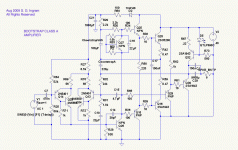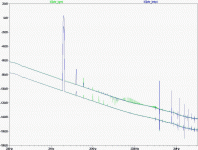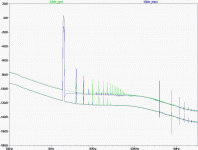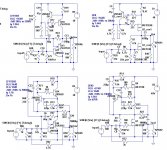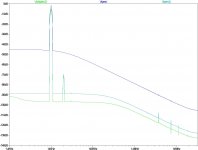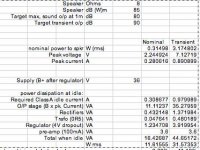Member
Joined 2009
Paid Member
I'd like some advice on this approach - it's likely not new but I haven't found any references to it yet - can you help ?
In looking at how I can reduce the standing power dissipation for a Class A amplifier the obvious place to start is with a lower constant current for the output device. I don't want a complex 'sliding bias' scheme or any other of the 'magic' methods I've heard about. It has to be simple.
Looking at my TGM amplifier (a 'standard' LTP - VAS - EF Class AB amp similar to AKSA, DX etc.) the voltage gain stage is a single BJT with a resistor collector load. The resistor is a 'poor mans' current source, but this Class A VAS stage is linearized with a boostrap cap from the ClassB output. (OK it is also linearized somewhat with the lag compensation cap too).
Taking this bootstrap concept to the output stage itself. I have added a SE Class A output stage to the existing Class B TGM amplifier. It employs a simple constant current source load to the output device. This constant current is purposely limited to reduce standing power dissipation, which means it isn't sufficient to allow the amplifier to avoid premature clipping. To allow higher signal levels (e.g. on transients) I then capacitively bootstrapped the output device from the ClassB output of the same amplifier.
At low signals (e.g. +/- 3V into 8 Ohm) the constant current source is sufficient to provide a pure SE Class A output. Nice (for those that like it). At higher signal levels the output device pulls current from the Class B output to stay in business.
As a further benefit, given that the constant current source is non-ideal the bootstrap is also able to provide low levels of current to 'correct' this deficiency and improve the performance of the amplifier.
I realize that there will be some feedthrough of the switching noise generated by the ClassB output. However, I suspect that it doesn't feed-through 100% to the load because, for the most part the switching transitions of the Class B output occur when the Class A output does not need bootstrap current so any current contributions from the Class B output are negligible as a % of the current flowing into the load.
Voila ! - less power disspation, little switching noise, no floating supplies required. Seems too good to be true ?
In looking at how I can reduce the standing power dissipation for a Class A amplifier the obvious place to start is with a lower constant current for the output device. I don't want a complex 'sliding bias' scheme or any other of the 'magic' methods I've heard about. It has to be simple.
Looking at my TGM amplifier (a 'standard' LTP - VAS - EF Class AB amp similar to AKSA, DX etc.) the voltage gain stage is a single BJT with a resistor collector load. The resistor is a 'poor mans' current source, but this Class A VAS stage is linearized with a boostrap cap from the ClassB output. (OK it is also linearized somewhat with the lag compensation cap too).
Taking this bootstrap concept to the output stage itself. I have added a SE Class A output stage to the existing Class B TGM amplifier. It employs a simple constant current source load to the output device. This constant current is purposely limited to reduce standing power dissipation, which means it isn't sufficient to allow the amplifier to avoid premature clipping. To allow higher signal levels (e.g. on transients) I then capacitively bootstrapped the output device from the ClassB output of the same amplifier.

At low signals (e.g. +/- 3V into 8 Ohm) the constant current source is sufficient to provide a pure SE Class A output. Nice (for those that like it). At higher signal levels the output device pulls current from the Class B output to stay in business.
As a further benefit, given that the constant current source is non-ideal the bootstrap is also able to provide low levels of current to 'correct' this deficiency and improve the performance of the amplifier.
I realize that there will be some feedthrough of the switching noise generated by the ClassB output. However, I suspect that it doesn't feed-through 100% to the load because, for the most part the switching transitions of the Class B output occur when the Class A output does not need bootstrap current so any current contributions from the Class B output are negligible as a % of the current flowing into the load.
Voila ! - less power disspation, little switching noise, no floating supplies required. Seems too good to be true ?

Last edited:
Member
Joined 2009
Paid Member
For some reason, the edit feature didn't allow me to correct the posting of the schematic so here's trying again...(left hand attachment)
And for those, like me, who have to tinker with simulations here are some preliminary results of the above circuit.
The middle attachment shows the harmonic spectra with a 4kHz input signal. There are two sets, the lower curves for a low signal (+/- 3V output) and the shifted-higher curves at +/- 15V (both into 8 Ohm resistor). The green curves are for a non-boostrapped version of the amp, the blue curves for the bootstrapped amp with Class A output.
The right hand attachment is the same deal, only at 10kHz signal. The bootstrapped amp shows nicely predominant H2, then H3, and it falls off quickly after that.
And for those, like me, who have to tinker with simulations here are some preliminary results of the above circuit.
The middle attachment shows the harmonic spectra with a 4kHz input signal. There are two sets, the lower curves for a low signal (+/- 3V output) and the shifted-higher curves at +/- 15V (both into 8 Ohm resistor). The green curves are for a non-boostrapped version of the amp, the blue curves for the bootstrapped amp with Class A output.
The right hand attachment is the same deal, only at 10kHz signal. The bootstrapped amp shows nicely predominant H2, then H3, and it falls off quickly after that.
Attachments
Graham Maynard, with the GEM amplifier, made something alike
Go back to the forum, last 3 years, and you will see a lot of nice ideas alike those ones you're posting... Graham loved bootstrapp and also JLH alike circuits, he has explored deeply many options about.
One circuit each day, this was his average production... and some are alike the ones you're posting.
This kind of circuit was deeply explored, and by many folks, each one of them bring some valuable contribution.
Thousands have made research on those amplifiers.... called and known as the very basic ones.... it is hard, now a days, many years latter the first one made (style, topology, bootstrapped, frame, three stages, common emitter output, single transistor VAS.... the Volkswagen beettle Amplifier).... hard to have really new ideas.... to imagine things others have not imagined before.... a good exercise, but hard to be original.
This one you posted (the idea, the central idea) was tried before, and worked fine.
I suggest you to take some time and build, listen, evaluate, compare and publish pictures..this way you gonna have a lot of people building too, and you gonna feel yourself very happy with your contribution to our communitty... doing different way..only you and your simulator will feel good.
Saddly simulators do not play music...maybe in the future we gonna have something able to do that.
regards,
Carlos
Go back to the forum, last 3 years, and you will see a lot of nice ideas alike those ones you're posting... Graham loved bootstrapp and also JLH alike circuits, he has explored deeply many options about.
One circuit each day, this was his average production... and some are alike the ones you're posting.
This kind of circuit was deeply explored, and by many folks, each one of them bring some valuable contribution.
Thousands have made research on those amplifiers.... called and known as the very basic ones.... it is hard, now a days, many years latter the first one made (style, topology, bootstrapped, frame, three stages, common emitter output, single transistor VAS.... the Volkswagen beettle Amplifier).... hard to have really new ideas.... to imagine things others have not imagined before.... a good exercise, but hard to be original.
This one you posted (the idea, the central idea) was tried before, and worked fine.
I suggest you to take some time and build, listen, evaluate, compare and publish pictures..this way you gonna have a lot of people building too, and you gonna feel yourself very happy with your contribution to our communitty... doing different way..only you and your simulator will feel good.
Saddly simulators do not play music...maybe in the future we gonna have something able to do that.
regards,
Carlos
Last edited:
Member
Joined 2009
Paid Member
Carlos,
Thanks for the input, you are a most valuable and helpful soul...
1/ So, I started by looking at this GEM amplifier here:
http://gmweb2.net/the_gem.htm
Some of this looks familiar - I believe I have looked at this amplfier right when I was first trying to design the TGM. Now I realize that I didn't understand the design at that time. For the first time I am now able to understand the GEM, or at least enough to see how it is different. The motivation and design path taken was very different to mine, but the resulting topology appears much the same in the key regard of combined ClassA and ClassAB. I also see the relationship to the Quad methodology.
[One thing that caught my eye was a -ve opinion on the performance of non-swtiching ClassB designs since this is a parallel area of investigation for me.]
And Graham's discourse reminds me that I should be including a more complex model of the speaker into my simulations.
2/ It is unfortunate that "Spice has no ears" but I do want to leverage from the experience of others who have built and listened to many amplifiers so that I might be more economical with my own ambitions to build and listen.
I realize why you responded so quickly to my thread - I also found a comment on the Forum that you were the first person after Graham to build the GEM. You wrote "my God!..... this amplifier is a Diamond!" and I found your comments on the sound of the amplifier very helpful because there are some comparisons against another amplifier that we like (AKSA).
I have to do some more reading to understand if this approach offers enough benefit worth it's complexity before I head off in the direction of Nelson's Zen....
Thanks for the input, you are a most valuable and helpful soul...
1/ So, I started by looking at this GEM amplifier here:
http://gmweb2.net/the_gem.htm
Some of this looks familiar - I believe I have looked at this amplfier right when I was first trying to design the TGM. Now I realize that I didn't understand the design at that time. For the first time I am now able to understand the GEM, or at least enough to see how it is different. The motivation and design path taken was very different to mine, but the resulting topology appears much the same in the key regard of combined ClassA and ClassAB. I also see the relationship to the Quad methodology.
[One thing that caught my eye was a -ve opinion on the performance of non-swtiching ClassB designs since this is a parallel area of investigation for me.]
And Graham's discourse reminds me that I should be including a more complex model of the speaker into my simulations.
2/ It is unfortunate that "Spice has no ears" but I do want to leverage from the experience of others who have built and listened to many amplifiers so that I might be more economical with my own ambitions to build and listen.
I realize why you responded so quickly to my thread - I also found a comment on the Forum that you were the first person after Graham to build the GEM. You wrote "my God!..... this amplifier is a Diamond!" and I found your comments on the sound of the amplifier very helpful because there are some comparisons against another amplifier that we like (AKSA).
I have to do some more reading to understand if this approach offers enough benefit worth it's complexity before I head off in the direction of Nelson's Zen....
Yeah...i remember it beated Aksa into the bass and dinamics..but i found some noises
and a little bit harshing high end...many times more than Aksa... as harshes too...well.... all amplifier harshes a little bit as have beating of low frequency harmonics together the pure tones.
A diamond..... and fast Graham changed the name to GEM.... Graham Ernest Maynard.... was his daddy.... a second world war mosquito pilot.... a heroe with medal and so on.
Graham received a lot of bombs... about the first cicle distortion and a lot of things he tried to teach us... some folks decided to jump into the thread to say.
I dislike
I do not buy that
I do not believe
I do not agree
It is not that way
people tried to disturb him....to be unkind... and forum management response was not the way he wanted... he gave up and now a days he is only building speakers and visiting the speaker forum.
You see... the old and good boostrapp was there... unavoidable thing if we want nice sound (that's what i think..there are controversies about... some disagreement..of course)
You see chips.... a lot of them using the VW beetle topologie.
Well...be happy..i am waiting you turn some schematic into real world and tell me how it sounds.then i will try it too.
regards,
Carlos
and a little bit harshing high end...many times more than Aksa... as harshes too...well.... all amplifier harshes a little bit as have beating of low frequency harmonics together the pure tones.
A diamond..... and fast Graham changed the name to GEM.... Graham Ernest Maynard.... was his daddy.... a second world war mosquito pilot.... a heroe with medal and so on.
Graham received a lot of bombs... about the first cicle distortion and a lot of things he tried to teach us... some folks decided to jump into the thread to say.
I dislike
I do not buy that
I do not believe
I do not agree
It is not that way
people tried to disturb him....to be unkind... and forum management response was not the way he wanted... he gave up and now a days he is only building speakers and visiting the speaker forum.
You see... the old and good boostrapp was there... unavoidable thing if we want nice sound (that's what i think..there are controversies about... some disagreement..of course)
You see chips.... a lot of them using the VW beetle topologie.
Well...be happy..i am waiting you turn some schematic into real world and tell me how it sounds.then i will try it too.
regards,
Carlos
Member
Joined 2009
Paid Member
Carlos,
It is interesting, the difference in trebles and bass.
I have built the AKSA-style clone (TGM, like DX...) and like the sound very much. In fact, the sound is so good, why would I build another kind of amplifier, life is short, I can focus instead on finding better music to play through my amplifier. But of course we get obsessed with this hobby and we look for something more.
You will have noticed my thoughts through my posts on the Forum where I want to reduce higher order harmonics, which I blame on NFB + cross-over distortion mostly. I looked at non-switching ClassB but so far I didn't find something elegant that makes me want to build it.
Then I looked at Class A, it seems perfect in every way. Some people complain it has less 'life', because of less 'dynamics' than ClassB. Well in my ignorance I think this is not because it is Class A but because of a 'lifeless' power supply - over regulated perhaps.
Class A is power hungry. I don't live in Brazil like you, in January the people here in Canada only show their noses from the inside of their big parka coats. So I'm not too concerned with power dissipation of Class A. But those big huge heatsinks and huge heavy transformers, big capacitors and soft-start circuits - huge chasis - things that are not elegant, this is what puts me off.
So if I can have the offspring from a marriage of Class A and Class B perhaps this is something I would be willing to build. I looked at Class G, but it has some flaws and can get complex, like some of the commercial amplifier circuits posted into my thread on that topic.
This past 24 hours I have read all of the Zen articles by Nelson. This fired up my enthusiasm further for Class A and for simple elegant amplifiers. How to rid those simple elegant amplifiers from the need for huge ugly power supplies
And so finally I came to this thread, which is found to be very similar to GEM concept, although far far less refined. Perhaps this is the answer. Graham took the JLH amplifier and made it into a Gem. I will think about taking a Zen and adding AKSA to make a "SAZEN" amplifier which I can build.
I want to make an amplifier to put on my desk, something elegant, not a big huge chasis. Something to drive two small speakers.
And so back to the first line in my message - why the difference in treble and bass between Gem and AKSA - how to get the AKSA trebble and Gem bass into SAZEN amplifier ?
Can we say that AKSA treble comes from something in the design, or in the harmonic profile ? - can we say that the prominent H2/3 that Hugh has engineered into AKSA is the answer. This is what the 'tube' guys look for. And Gem was not designed for H2/3, so we put H2/3 into SAZEN for good trebble.
Can we say that Gem bass comes from proper consideration of amplifier-speaker interaction, with low H2/3 which might otherwise muddy the bass ? That is comes from having the dynamic headroom of a Class AB output ?
It is interesting, the difference in trebles and bass.
I have built the AKSA-style clone (TGM, like DX...) and like the sound very much. In fact, the sound is so good, why would I build another kind of amplifier, life is short, I can focus instead on finding better music to play through my amplifier. But of course we get obsessed with this hobby and we look for something more.
You will have noticed my thoughts through my posts on the Forum where I want to reduce higher order harmonics, which I blame on NFB + cross-over distortion mostly. I looked at non-switching ClassB but so far I didn't find something elegant that makes me want to build it.
Then I looked at Class A, it seems perfect in every way. Some people complain it has less 'life', because of less 'dynamics' than ClassB. Well in my ignorance I think this is not because it is Class A but because of a 'lifeless' power supply - over regulated perhaps.
Class A is power hungry. I don't live in Brazil like you, in January the people here in Canada only show their noses from the inside of their big parka coats. So I'm not too concerned with power dissipation of Class A. But those big huge heatsinks and huge heavy transformers, big capacitors and soft-start circuits - huge chasis - things that are not elegant, this is what puts me off.
So if I can have the offspring from a marriage of Class A and Class B perhaps this is something I would be willing to build. I looked at Class G, but it has some flaws and can get complex, like some of the commercial amplifier circuits posted into my thread on that topic.
This past 24 hours I have read all of the Zen articles by Nelson. This fired up my enthusiasm further for Class A and for simple elegant amplifiers. How to rid those simple elegant amplifiers from the need for huge ugly power supplies
And so finally I came to this thread, which is found to be very similar to GEM concept, although far far less refined. Perhaps this is the answer. Graham took the JLH amplifier and made it into a Gem. I will think about taking a Zen and adding AKSA to make a "SAZEN" amplifier which I can build.
I want to make an amplifier to put on my desk, something elegant, not a big huge chasis. Something to drive two small speakers.
And so back to the first line in my message - why the difference in treble and bass between Gem and AKSA - how to get the AKSA trebble and Gem bass into SAZEN amplifier ?
Can we say that AKSA treble comes from something in the design, or in the harmonic profile ? - can we say that the prominent H2/3 that Hugh has engineered into AKSA is the answer. This is what the 'tube' guys look for. And Gem was not designed for H2/3, so we put H2/3 into SAZEN for good trebble.
Can we say that Gem bass comes from proper consideration of amplifier-speaker interaction, with low H2/3 which might otherwise muddy the bass ? That is comes from having the dynamic headroom of a Class AB output ?
I am very sorry... really sorry...i would like to tell you..but i cannot
not only some questions i am unable to answer, and some others i have not authorization to talk about.
I do agree... Aksa sounds very nice..also Dx amplifier and your Tgm and many others that use the topologie... aksa has some special effects, but i cannot comment...only Hugh can open the stuff to public.
This topologie is really sounding very good..... surfing the web, i use to find people very happy and publishing sound tests (Youtube) using lovely vintage units..and you go to search the schematic and there's the topologie.... some of them are alike our amplifiers..others look alike Symassym using Fets into the input differential or some combination of bgts and fets.... and people very happy with sonics.
Since those early days of my youth (seventies) i found amplifiers going to be more and more complex... Fets were used and several complications were added as surrounding auxiliary sub circuits... also double complementary differential were used (Leach alike)...but all those sounded strange (to me).
If you want to know what i think... in a fast and short form.... topologie sounds!... bootstrapp is great!.... decisions about WHAT harmonics will be increase or decreased is important and speaker tuning to the amplifier (matched things) results the best.
Class A is impossible in my country...too much hot here...but may be lovely to Canada during the winter...not kidding..we can even sit on them to feel our back soft cushion confortable.
We can put our feet over them, also to keep coffee warm ..... i would be using class A too during winter..no doubts...and Nelson Pass (heaters) would be the prefered ones because philosophy... low parts count...simple circuits not to distort (each stage contributes to the final mess).
I really would like to answer you...unfortunatelly i cannot give you all those answers..some i do not know..others i really cannot (copyrigth secrets, ideas not mine).
But you have touched some secrets and some ideas..i really think your future amplifier will be excelent, if loose to Aksa..will be for a nose (horse race)
You could see that Hugh was around...he used to follow some of your threads..he found value on you...he knows when people is good... and i have complained with him..i said:
- What a hell Hugh!... those folks are just doing the same amplifier over and over again..this is boring Hugh!..and you are supporting that stuff!
He said..some of those guys are really good.... Bigun is nice!
You have a good friend on him Bigun...and hugh friends are my friends too.
regards,
Carlos
not only some questions i am unable to answer, and some others i have not authorization to talk about.
I do agree... Aksa sounds very nice..also Dx amplifier and your Tgm and many others that use the topologie... aksa has some special effects, but i cannot comment...only Hugh can open the stuff to public.
This topologie is really sounding very good..... surfing the web, i use to find people very happy and publishing sound tests (Youtube) using lovely vintage units..and you go to search the schematic and there's the topologie.... some of them are alike our amplifiers..others look alike Symassym using Fets into the input differential or some combination of bgts and fets.... and people very happy with sonics.
Since those early days of my youth (seventies) i found amplifiers going to be more and more complex... Fets were used and several complications were added as surrounding auxiliary sub circuits... also double complementary differential were used (Leach alike)...but all those sounded strange (to me).
If you want to know what i think... in a fast and short form.... topologie sounds!... bootstrapp is great!.... decisions about WHAT harmonics will be increase or decreased is important and speaker tuning to the amplifier (matched things) results the best.
Class A is impossible in my country...too much hot here...but may be lovely to Canada during the winter...not kidding..we can even sit on them to feel our back soft cushion confortable.
We can put our feet over them, also to keep coffee warm ..... i would be using class A too during winter..no doubts...and Nelson Pass (heaters) would be the prefered ones because philosophy... low parts count...simple circuits not to distort (each stage contributes to the final mess).
I really would like to answer you...unfortunatelly i cannot give you all those answers..some i do not know..others i really cannot (copyrigth secrets, ideas not mine).
But you have touched some secrets and some ideas..i really think your future amplifier will be excelent, if loose to Aksa..will be for a nose (horse race)
You could see that Hugh was around...he used to follow some of your threads..he found value on you...he knows when people is good... and i have complained with him..i said:
- What a hell Hugh!... those folks are just doing the same amplifier over and over again..this is boring Hugh!..and you are supporting that stuff!
He said..some of those guys are really good.... Bigun is nice!
You have a good friend on him Bigun...and hugh friends are my friends too.
regards,
Carlos
Last edited:
Member
Joined 2009
Paid Member
It's great indeed to be in good company with people here who are kind enough to share their knowledge and encouragement.
Of course, let's not discuss details of AKSA, but we can talk about general items, like harmonic profile without disclosing how this profile was achieved and we can say some things about general topologies that affect sonics and which are not 'secret'.
I will study a bit more...
And now I find myself with two nice boxes to make homes for ClassA afterall. They are very nice high end Acopian linear power supplies - I have two. They are old enough that their owner no longer uses them and one of them at least is Kaput. They have outboard heatsinks with 3055's on them. They have nice analogue meters on the front, the old style with moving needles in them. But first I need something for the desktop.
Of course, let's not discuss details of AKSA, but we can talk about general items, like harmonic profile without disclosing how this profile was achieved and we can say some things about general topologies that affect sonics and which are not 'secret'.
I will study a bit more...
And now I find myself with two nice boxes to make homes for ClassA afterall. They are very nice high end Acopian linear power supplies - I have two. They are old enough that their owner no longer uses them and one of them at least is Kaput. They have outboard heatsinks with 3055's on them. They have nice analogue meters on the front, the old style with moving needles in them. But first I need something for the desktop.
Communication is hard...not because language problems, but because
listening music is a feeling...we feel with our brain.... and to talk about is subjective and can be very generic if translated to simple words.
Sadly we have to work hard, to build several options, to compare them and "feel" the sound... to say leach style sounds not so good, is very subjective and some will never agreed.
Simetrical things has a strong appeal to humans..they think this is good... they are more rational, has more logics.... big chances to be better...sadly they are not.
I told that (Leach style sounds strange...bass is stucked alike an obstructed plumbing that does not let watter flow) to some friends that decided to check..then they built and have listened..then they have build something standard alike ours...then they compare...you see..no preference..both amplifiers were made by the same man...no amplifier was their "son"...so...no special feelings... they have listened thinking on sound reproduction, not in music or musicality, not in musical text and not about the singer was saying.... attention to instruments, presence, deepness of field, the sound stage, how brigth or how warm, how precise or not...good to listen or not..tiring or not?...those things.
Some of them (majority) concluded our standard is much better, 30 percent said different.
This is communication...they have lived (listened) and experienced the same thing i had..they have compared...now they understand what i mean... even the ones disagree, now they know what i mean..they can understand the sonic warmth was my preference..and now they know what is warmth to me... now warmth is something already communicatted with them.
This is the only way i know how to communicatte...people have to experience the same thing to evaluate... and even this way, some differences in speakers may confuse us a little.
"I think so" is not scientific.... "I know" is different, and has more strengh.... and to know sonics..have to build or to listen both amplifiers... the ones that listen and compare really knows..others goes thinking.
Also this is a matter of choise...many folks prefere to believe..this is more interesting..not to test nothing..not to compare..alike religion..i never could see an Anjo but i believe.... some folks has this kind of choices..then they belief Brands.... they believe Fame... they believe in price..all those things are more important to those prefere not to "know"
regards,
Carlos
listening music is a feeling...we feel with our brain.... and to talk about is subjective and can be very generic if translated to simple words.
Sadly we have to work hard, to build several options, to compare them and "feel" the sound... to say leach style sounds not so good, is very subjective and some will never agreed.
Simetrical things has a strong appeal to humans..they think this is good... they are more rational, has more logics.... big chances to be better...sadly they are not.
I told that (Leach style sounds strange...bass is stucked alike an obstructed plumbing that does not let watter flow) to some friends that decided to check..then they built and have listened..then they have build something standard alike ours...then they compare...you see..no preference..both amplifiers were made by the same man...no amplifier was their "son"...so...no special feelings... they have listened thinking on sound reproduction, not in music or musicality, not in musical text and not about the singer was saying.... attention to instruments, presence, deepness of field, the sound stage, how brigth or how warm, how precise or not...good to listen or not..tiring or not?...those things.
Some of them (majority) concluded our standard is much better, 30 percent said different.
This is communication...they have lived (listened) and experienced the same thing i had..they have compared...now they understand what i mean... even the ones disagree, now they know what i mean..they can understand the sonic warmth was my preference..and now they know what is warmth to me... now warmth is something already communicatted with them.
This is the only way i know how to communicatte...people have to experience the same thing to evaluate... and even this way, some differences in speakers may confuse us a little.
"I think so" is not scientific.... "I know" is different, and has more strengh.... and to know sonics..have to build or to listen both amplifiers... the ones that listen and compare really knows..others goes thinking.
Also this is a matter of choise...many folks prefere to believe..this is more interesting..not to test nothing..not to compare..alike religion..i never could see an Anjo but i believe.... some folks has this kind of choices..then they belief Brands.... they believe Fame... they believe in price..all those things are more important to those prefere not to "know"
regards,
Carlos
Last edited:
Member
Joined 2009
Paid Member
This is why we are obsessed with this hobby - it's not entirely rational.
Even the name is important. Who wouldn't enjoy the sound of an amplifier called ZEN ?
Carlos - did you build with Mosfets, and how did you feel about those amplifiers ?
For Class A they have a lot of supporters, perhaps my proposal for something like GEM should contain MOSFETs and BJTs.
Even the name is important. Who wouldn't enjoy the sound of an amplifier called ZEN ?
Carlos - did you build with Mosfets, and how did you feel about those amplifiers ?
For Class A they have a lot of supporters, perhaps my proposal for something like GEM should contain MOSFETs and BJTs.
I feel them mufled..but seems i am the only one that thinks this way
maybe i have dozen supporters.
I do not like them.... this is very personal i think..empathy.... and you know, those things changes (influences) our evaluation... we are not only ears..we have an entire system's processing.
They are nice for switching purposes...and frequency response is awsome...capacitance is no good.
Yes, i have assembled some..and i felt them alike you listening with an equalizer having 14K and upper frequencies attenuated.
Yes, i know that this seems my ears are loosing above 14Khz...i am 58 years old, and this happens...but....other amplifiers, using BGTs does not show me this effect.
You know bigun.... audio perception and several human perceptions are intimatelly connected with our feelings.... we can adjust audio..we have internal processing...brain processing..and this depends our "will".... when you are in love for a woman... deeply in passion.... say... crazy for her....you can be into the most noisy place on earth...the fifth Avenue in New York....or Shinjuku in Japan... automobile horns producing noises, engines, people talking....but when you met the woman in front of you, all noises disappear...you will see her lips moving slowly in front of you, all words will be listened and you will enter another dimension of time.... a deep silence will be with you..only her words and her image will be presented to your conscience.
So... emotions changes everything, including musical perception, tastes, and also quality evaluation.
Do not believe Fets are mufled...just believe there are folks that dislike it, and maybe because of several reasons, they perceive it mufled.
Also, i have to tell you i have not made the blind testing.... you see...i really do not even want to know the truth.
Bgts are old passion that i do not want to betray...maybe this is the main reason..old friend...old company...a very long time with me.
regards,
Carlos
maybe i have dozen supporters.
I do not like them.... this is very personal i think..empathy.... and you know, those things changes (influences) our evaluation... we are not only ears..we have an entire system's processing.
They are nice for switching purposes...and frequency response is awsome...capacitance is no good.
Yes, i have assembled some..and i felt them alike you listening with an equalizer having 14K and upper frequencies attenuated.
Yes, i know that this seems my ears are loosing above 14Khz...i am 58 years old, and this happens...but....other amplifiers, using BGTs does not show me this effect.
You know bigun.... audio perception and several human perceptions are intimatelly connected with our feelings.... we can adjust audio..we have internal processing...brain processing..and this depends our "will".... when you are in love for a woman... deeply in passion.... say... crazy for her....you can be into the most noisy place on earth...the fifth Avenue in New York....or Shinjuku in Japan... automobile horns producing noises, engines, people talking....but when you met the woman in front of you, all noises disappear...you will see her lips moving slowly in front of you, all words will be listened and you will enter another dimension of time.... a deep silence will be with you..only her words and her image will be presented to your conscience.
So... emotions changes everything, including musical perception, tastes, and also quality evaluation.
Do not believe Fets are mufled...just believe there are folks that dislike it, and maybe because of several reasons, they perceive it mufled.
Also, i have to tell you i have not made the blind testing.... you see...i really do not even want to know the truth.
Bgts are old passion that i do not want to betray...maybe this is the main reason..old friend...old company...a very long time with me.
regards,
Carlos
Member
Joined 2009
Paid Member
Well, it's a very good thing that a beautiful woman can still get our attention 
Still, I don't think I've ever heard an amplifier with MOSFETs - although many years ago I did audition a KRELL system which was Class A but I don't know what kind of output devices. I don't remember much about the sound, it was my first ever chance to hear a real system, the first time that I heard sound floating free of the speakers - it was quite startling.
As you say, I need to think about building some things again, get away from simulations and perhaps I need to listen to some different things than the TGM.
I do have a question on the GEM amplifier that I couldn't, with my lazy brain, figure out from the schematic. There is a Class A part of the output that is biassed at some nominal idle current. When the output signal exceeds this idle current the Class B devices provide the necessary additional power for the load. When this happens, does the Class A device turn off ????
In my simulations of my design shown earlier in this thread, the Class A output device does switch off for large enough signals. It must contaminate the output signal and perhaps the turn-off is not very graceful. If the GEM suffers from this, it could be a reason why you didn't like the treble as much as AKSA which has optimized output to minimize this affect.
Still, I don't think I've ever heard an amplifier with MOSFETs - although many years ago I did audition a KRELL system which was Class A but I don't know what kind of output devices. I don't remember much about the sound, it was my first ever chance to hear a real system, the first time that I heard sound floating free of the speakers - it was quite startling.
As you say, I need to think about building some things again, get away from simulations and perhaps I need to listen to some different things than the TGM.
I do have a question on the GEM amplifier that I couldn't, with my lazy brain, figure out from the schematic. There is a Class A part of the output that is biassed at some nominal idle current. When the output signal exceeds this idle current the Class B devices provide the necessary additional power for the load. When this happens, does the Class A device turn off ????
In my simulations of my design shown earlier in this thread, the Class A output device does switch off for large enough signals. It must contaminate the output signal and perhaps the turn-off is not very graceful. If the GEM suffers from this, it could be a reason why you didn't like the treble as much as AKSA which has optimized output to minimize this affect.
The Gem used two power output pairs...or two output systems
One a normal, standard, emitter follower, class AB amplifier... switching during crossover alike all class AB,.
The other ouput was biased class A, but not a very high bias.... i cannot remember but seems was around 500 miliamperes...so... at high levels it also used to switch during crossover.
He used this method to attenuate crossover spikes because of that higher current always flowing into the class A output.
Into power lower than 10 watts RMS, the distortion produced into the class AB amplifier crossover points is atenuated and you have a better audio, result of this mix of class A with class AB.
Was a trick that sounded fine... the audio quality advantage was perceived...i had annoying noises, and Graham said was because my construction, the way i have assembled...he has posted the method he used to connect power and drivers using wires, a point to point connection.
Do not worry because i told harshing...this does not means something absolute.... when you compare two amplifiers, you observe and have attention to each performance "sector" each time....when you have attention to the harshing you will see that one harshes always less than the other...in the reality all then harshes, depending the type of tones you have..bells with a lot of harmonics, metals hitted, always harshes.
Comparing A with B amplifiers, you can say B harshes more than A...but you cannot say it harshes more or harshes less than the other zillion or amplifiers exists in this world..all you can say is about that one...the "A"...and that other one compared with....the "B" one...nothing more we can say.
Sometimes not A and nor B harshes too much...sometimes harshes almost nothing, or very low harshing level.. compare to the entire population of world amplifiers.... harshing more does not means the amplifier is a harshing defective device...means it harshes when compared with that other one, and only under such kind of condition....maybe will be considered a non harshing amplifier compared with others..not absolute thing..nothing enougth to give it a tittle of harshing one.
I am smaller than my friend bear...but we cannot say i am a short man, a non tall man...i have around 184 centimeters....much more than 5 feet and several inches...i am short, only when you compare me with Bear..he is a giant, almost a foot taller than me.
Bear appear in this picture...the small guys you see are special troops really big guys..the smaller one has 185 centimeters tall.... much higher than brazilian average that is 165 centimeters tall.... they are strong elite trops for jungle battle and they are a bunch of muscles...they appear small, alike kids..they are not.... huge guys they are..but compared to Bear they are nothing.... this is the A to B comparison problem...all you can realise is inside the A to B method... C, D, E, F and so on we cannot conclude too much without enormous work...very hard to do.
regards,
Carlos
One a normal, standard, emitter follower, class AB amplifier... switching during crossover alike all class AB,.
The other ouput was biased class A, but not a very high bias.... i cannot remember but seems was around 500 miliamperes...so... at high levels it also used to switch during crossover.
He used this method to attenuate crossover spikes because of that higher current always flowing into the class A output.
Into power lower than 10 watts RMS, the distortion produced into the class AB amplifier crossover points is atenuated and you have a better audio, result of this mix of class A with class AB.
Was a trick that sounded fine... the audio quality advantage was perceived...i had annoying noises, and Graham said was because my construction, the way i have assembled...he has posted the method he used to connect power and drivers using wires, a point to point connection.
Do not worry because i told harshing...this does not means something absolute.... when you compare two amplifiers, you observe and have attention to each performance "sector" each time....when you have attention to the harshing you will see that one harshes always less than the other...in the reality all then harshes, depending the type of tones you have..bells with a lot of harmonics, metals hitted, always harshes.
Comparing A with B amplifiers, you can say B harshes more than A...but you cannot say it harshes more or harshes less than the other zillion or amplifiers exists in this world..all you can say is about that one...the "A"...and that other one compared with....the "B" one...nothing more we can say.
Sometimes not A and nor B harshes too much...sometimes harshes almost nothing, or very low harshing level.. compare to the entire population of world amplifiers.... harshing more does not means the amplifier is a harshing defective device...means it harshes when compared with that other one, and only under such kind of condition....maybe will be considered a non harshing amplifier compared with others..not absolute thing..nothing enougth to give it a tittle of harshing one.
I am smaller than my friend bear...but we cannot say i am a short man, a non tall man...i have around 184 centimeters....much more than 5 feet and several inches...i am short, only when you compare me with Bear..he is a giant, almost a foot taller than me.
Bear appear in this picture...the small guys you see are special troops really big guys..the smaller one has 185 centimeters tall.... much higher than brazilian average that is 165 centimeters tall.... they are strong elite trops for jungle battle and they are a bunch of muscles...they appear small, alike kids..they are not.... huge guys they are..but compared to Bear they are nothing.... this is the A to B comparison problem...all you can realise is inside the A to B method... C, D, E, F and so on we cannot conclude too much without enormous work...very hard to do.
regards,
Carlos
Attachments
Last edited:
Thank you Lumba....your agreement is important, as you are clever, skilled and a
very respectable guy into our community....your agreement promotes me an means a nice ego massage.
Now it is my departure time to the beach..... Coral Bay...near Gaibú....30 kilometers south of Recife.
regards,
Carlos
very respectable guy into our community....your agreement promotes me an means a nice ego massage.
Now it is my departure time to the beach..... Coral Bay...near Gaibú....30 kilometers south of Recife.
regards,
Carlos
Attachments
Member
Joined 2009
Paid Member
The "CFP ZEN" amplifier
With a friend like Bear, you can build one of those big Class A monsters and you'll have somebody who can move it for you !!!!
We will have to remember not to mess with Carlos !
OK, I won't be too worried about 'harsh' amplifiers quite yet.
Considering Class A and ClassAB combination I started with Papa's Zen. And how to do this with BJTs for you Carlos.....Although, I must confess that I still have BJTs left over from my TGM build to use up but no MOSFETs so this is of interest.
I did some listening tests with my TGM amp + CRO and for my 8R speakers I only need +/-1V output, +/-3V when cranked up loud. Allowing for transients means 1.5A of idle current will be OK.
A disadvantage BJTs is the high base current at idle in Class A when compared with the MOSFET. At higher frequencies the MOSFET gate capacitance is a disadvantage, but not at idle. This complicates the biassing, I need a driver for the BJT output device. I decided to try a CFP arrangement and have called this the "CFP ZEN" amplifier.
The simulations depend a lot on the quality of the device models. It means comparisons between two circuits that are similar are reasonably safe in terms of trends/improvements, but between a BJT and MOSFET amp I suspect it's very hard to draw conclusions. Nevertheless, the FFT results show similar magnitudes for harmonics, plus the lower noise floor for the BJT circuit reveals more of the structure. (BTW you get the best results at 2A, just like Nelson designed it).
In the next generation Zen, Nelson incorporated the Aleph current source. I'm not sure if I have this implemented correctly in the CFP ZEN. The OLG for Zen2 rises from around 12dB to 26dB allowing the use of some global feedback. In my sims this pulls the noise floor down but not the harmonics. There are likely quite a few errors in my design, bias points, loading on the input etc. so if anyone would like to weigh-in on the posted schematic it will help my education...
NB. Please refer to here [http://www.passdiy.com/pdf/zenamp.pdf ] for the proper source of information on Nelson's Zen amplifiers and NOT my scribbling
With a friend like Bear, you can build one of those big Class A monsters and you'll have somebody who can move it for you !!!!
We will have to remember not to mess with Carlos !
OK, I won't be too worried about 'harsh' amplifiers quite yet.
Considering Class A and ClassAB combination I started with Papa's Zen. And how to do this with BJTs for you Carlos.....Although, I must confess that I still have BJTs left over from my TGM build to use up but no MOSFETs so this is of interest.
I did some listening tests with my TGM amp + CRO and for my 8R speakers I only need +/-1V output, +/-3V when cranked up loud. Allowing for transients means 1.5A of idle current will be OK.
A disadvantage BJTs is the high base current at idle in Class A when compared with the MOSFET. At higher frequencies the MOSFET gate capacitance is a disadvantage, but not at idle. This complicates the biassing, I need a driver for the BJT output device. I decided to try a CFP arrangement and have called this the "CFP ZEN" amplifier.
The simulations depend a lot on the quality of the device models. It means comparisons between two circuits that are similar are reasonably safe in terms of trends/improvements, but between a BJT and MOSFET amp I suspect it's very hard to draw conclusions. Nevertheless, the FFT results show similar magnitudes for harmonics, plus the lower noise floor for the BJT circuit reveals more of the structure. (BTW you get the best results at 2A, just like Nelson designed it).
In the next generation Zen, Nelson incorporated the Aleph current source. I'm not sure if I have this implemented correctly in the CFP ZEN. The OLG for Zen2 rises from around 12dB to 26dB allowing the use of some global feedback. In my sims this pulls the noise floor down but not the harmonics. There are likely quite a few errors in my design, bias points, loading on the input etc. so if anyone would like to weigh-in on the posted schematic it will help my education...

NB. Please refer to here [http://www.passdiy.com/pdf/zenamp.pdf ] for the proper source of information on Nelson's Zen amplifiers and NOT my scribbling
Attachments
Member
Joined 2009
Paid Member
Yes, it's pretty nasty that way - lots of power.
I'm still thinking about Class G and other methods to cut this down.
My calculations also came to 50W, but I am thinking of reducing the supply to 36V and the idle current to 1A, still it's 30W - yikes !
We'll make a version for Bear.
I'm still thinking about Class G and other methods to cut this down.
My calculations also came to 50W, but I am thinking of reducing the supply to 36V and the idle current to 1A, still it's 30W - yikes !
We'll make a version for Bear.
Attachments
Member
Joined 2009
Paid Member
50 watts iddle.
thank you,
regards from Bear..... 57 centimeters is his neck diameter.
Carlos
But how will he deal with Canadian Bear ?
Where I go camping, they sometimes eat people

Attachments
- Status
- This old topic is closed. If you want to reopen this topic, contact a moderator using the "Report Post" button.
- Home
- Amplifiers
- Solid State
- Bootstrapped ClassA - ?
